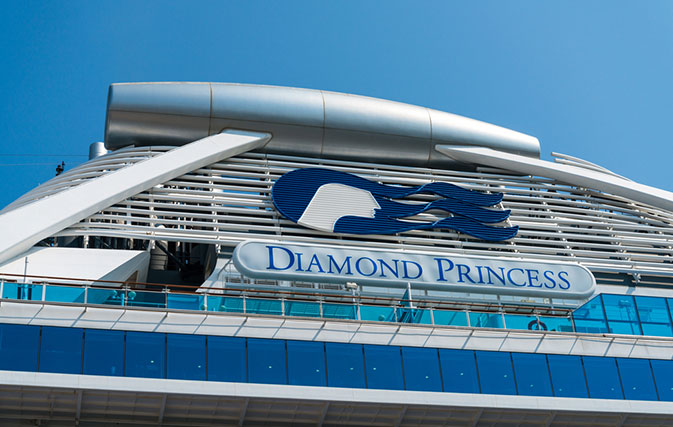TOKYO — Canadians stranded on a quarantined cruise ship were told that a flight set to bring them home is “expected” to depart Tokyo Haneda Airport on Thursday amid an outbreak of the novel coronavirus.
Passengers will be informed of the “exact departure time approximately 24 hours before the flight,” reads an email received by passengers aboard the Diamond Princess cruise ship docked at a port near Tokyo.
“It is important that you remain on the ship until you are instructed to board the assisted Canadian flight, even if you are cleared to leave because you have completed the ship quarantine,” says the email received Tuesday evening local time from Global Affairs.
“Please note that if you leave the ship before you are instructed to do so, it will not be possible to board the assisted Canadian flight.”
Should passengers choose not to return on the charter flight, they will need to complete the current quarantine being administered by Japan and follow the instructions of local authorities, it says.
Canadians seeking to return to home by commercial means will be subject to the Quarantine Act, in line with a determination to be made by the Public Health Agency of Canada, it says.
This could include a further quarantine of 14 days, it reads.
An email sent Monday evening said it took the government time to organize this evacuation because the flight departure from Lisbon was delayed by “several hours due to overflight clearance challenges.”
As many as 255 Canadians are on the Diamond Princess, where some 3,500 passengers have been stuck for at least 10 days. So far, 355 people have been infected, including 15 from Canada.
The largest number of cases outside China is among passengers and crew of the Diamond Princess cruise ship. The Japanese Health Ministry has tested 1,723 people among the 3,700 initially on board, and 454 have tested positive.
The U.S. evacuated 338 American passengers early Monday, with most of them placed in a 14-day quarantine at military bases in California and Texas.
Global Affairs Canada said on Saturday that the aircraft will bring passengers from Japan to Canadian Forces Base Trenton in southern Ontario. There they will be assessed and transported to the NAV Canada Training Institute in Cornwall, Ont., to undergo a further 14-day period of quarantine.
Before boarding in Japan, passengers will be screened for symptoms; those who exhibit symptoms of COVID-19 will not be permitted to board and will instead be transferred to the Japanese health system to receive appropriate care.
Experts have questioned if the close quarters have contributed to the virus’ spread. A growing number of scientists say the ship served as an incubator for the worrying new virus.
The Japanese government has repeatedly defended the effectiveness of the quarantine. But some scientists suggest that it may have been less than rigorous.
In a possible sign of lax quarantine protocols, three Japanese health officials who helped in the quarantine checks on the ship were also infected.
“Obviously the quarantine hasn’t worked, and this ship has now become a source of infection,” said Dr. Nathalie MacDermott, an outbreak expert at King’s College London.
She said the exact mechanism of the virus’ spread was unknown.
“We need to understand how the quarantine measures on board were implemented, what the air filtration on board is like, how the cabins are connected and how waste products are disposed of,” MacDermott said.
Some passengers on the Diamond Princess described the ship as a “floating prison” but were allowed to walk on the decks every day while wearing a mask and were told to keep their distance from others.
Dr. Paul Hunter, a professor of medicine at the University of East Anglia in England, said the continued spread of the virus could be due to compliance problems.
“It’s difficult to enforce a quarantine in a ship environment and I’m absolutely sure there were some passengers who think they’re not going to let anyone tell them what they can and cannot do,” he said. “Given how the virus has continued to spread, we have to presume everyone leaving the ship is potentially infected, and therefore they have to go through another two-week quarantine period. Not to do so would be reckless.”
Japanese health officials say a 14-day quarantine on the ship is adequate, citing results that all but one of more than 500 Japanese returnees from Wuhan, the epicenter of the virus in China, who initially tested negative were also found to be virus-free at the end of their 14-day quarantine at government facilities.
Those officials also have defended precautions taken on the ship. About 1,000 crew members were told to wear surgical masks, wash their hands, use disinfectant sprays and stop operations at restaurants, bars and other entertainment areas after Feb. 5, when the first group of 10 infected people were reported and the official start of the 14-day quarantine was announced.
Passengers were instructed to stay in their cabins and not walk around or contact other passengers. Those in windowless cabins could go out on the deck to take a walk or exercise for about an hour each day.
With files from The Canadian Press and The Associated Press

